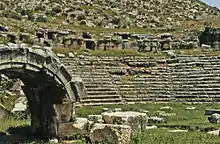Limyra
Limyra (Ancient Greek: Λίμυρα)[1] was a small city in ancient Lycia on the southern coast of Asia Minor, on the Limyrus River (Ancient Greek: Λιμύρος).[2][3] Already flourishing in the second millennium BCE, the city was one of the oldest and most prosperous in Lycia; it gradually became one of the finest trade settlements in Greece.
Λίμυρα | |
 Limyra Theater | |
 Shown within Turkey | |
| Location | Antalya Province, Turkey |
|---|---|
| Region | Lycia |
| Coordinates | 36.343873°N 30.171289°E |
| Type | Settlement |
| History | |
| Cultures | Hellenic/Persian |
| Site notes | |
| Condition | In ruins |
In the 4th century BCE Pericles adopted it as the capital of the Lycian League; subsequently it came under control of the Persian Empire.[4][5][6] After Alexander the Great ended Persian rule, most of Lycia was ruled by Ptolemy I Soter; his son Ptolemy II Philadelphos supported the Limyrans against the invading Galatians and the inhabitants dedicated a monument, the Ptolemaion, to him in thanks.
The five necropolises from this period demonstrate the city's importance. The mausoleum of Pericles is particularly notable for its fine reliefs and exquisite sculptures such as Perseus slaying Medusa and one of her sisters.[6]
Limyra is mentioned by Strabo (XIV, 666), Ptolemy (V, 3, 6) and several Latin authors. Gaius Caesar, adopted son of Augustus, died there (Velleius Paterculus, II, 102).
The Romans cut a theater into the hill which held 8000 spectators. It was commissioned in the second century AD by important Lycian benefactor named Opramoas of Rhodiapolis. Also from this period are a bathhouse with a complex heating system and the colonnaded streets. The Roman Bridge at Limyra, east of the city, is one of the oldest segmental arch bridges in the world.[7]
Ecclesiastical history
Limyra is mentioned as a bishopric in Notitiæ Episcopatuum down to the 12th and 13th centuries as a suffragan of the metropolitan of Myra.
Six bishops are known: Diotimus, mentioned by St. Basil (ep. CCXVIII); Lupicinus, present at the First Council of Constantinople, 381; Stephen, at the Council of Chalcedon (451); Theodore, at the Second Council of Constantinople in 553; Leo, at the Second Council of Nicaea in 787; Nicephorus, at the Council of Constantinople (879-880).[7]
In the Annuario Pontificio it is listed as a titular see of the Roman province of Lycia.[8]
Gallery
 Limyra Theatre from uphill
Limyra Theatre from uphill Limyra Theatre
Limyra Theatre Limyra Theatre corridors
Limyra Theatre corridors Limyra Cenotaph of Gaius Caesar
Limyra Cenotaph of Gaius Caesar Limyra Cenotaph Gaius Caesar in Antalya Museum
Limyra Cenotaph Gaius Caesar in Antalya Museum Limyra Ptolemaion
Limyra Ptolemaion Limyra Ptolemaion relief in Antalya Museum
Limyra Ptolemaion relief in Antalya Museum Limyra Bee keeping
Limyra Bee keeping Limyra tomb of Tebursseli
Limyra tomb of Tebursseli Limyra tomb of Tebursseli decoration
Limyra tomb of Tebursseli decoration Limyra Temple-type tomb
Limyra Temple-type tomb Limyra Sarcophagus of Xñtabura
Limyra Sarcophagus of Xñtabura Limyra Rock graves
Limyra Rock graves Limyra Heroon Pericles in Antalya Museum
Limyra Heroon Pericles in Antalya Museum Limyra Roman Bridge
Limyra Roman Bridge
References
- Stephanus of Byzantium, Ethnica, §L417.15
- Strabo, Geography, 14.3.7
- Stephanus of Byzantium, Ethnica, L417.15
- Houwink ten Cate, Philo Hendrik Jan (1961). The Luwian Population Groups of Lycia and Cilicia Aspera During the Hellenistic Period. Brill Archive. p. 12–13.
- Briant, Pierre (2002). From Cyrus to Alexander: A History of the Persian Empire. Eisenbrauns. p. 673. ISBN 9781575061207.
- Bryce, Trevor (2009). The Routledge Handbook of the Peoples and Places of Ancient Western Asia: The Near East from the Early Bronze Age to the fall of the Persian Empire. Routledge. p. 419. ISBN 9781134159079.
- Sopheone Pétridès, "Limyra" in Catholic Encyclopedia (New York 1910)
- Annuario Pontificio 2013 (Libreria Editrice Vaticana 2013 ISBN 978-88-209-9070-1), p. 917
| Wikimedia Commons has media related to Limyra. |